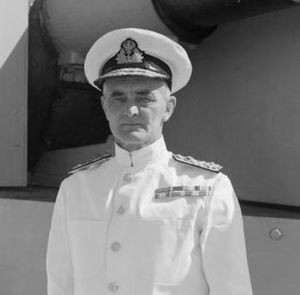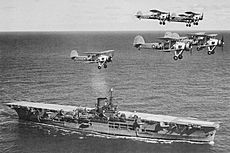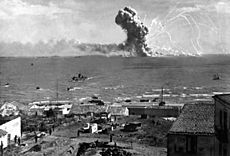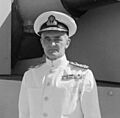Arthur Power facts for kids
Quick facts for kids
Sir Arthur Power
|
|
|---|---|

Power in 1942
|
|
| Birth name | Arthur John Power |
| Born | 12 April 1889 London, England |
| Died | 28 January 1960 (aged 70) Royal Naval Hospital, Haslar |
| Allegiance | United Kingdom |
| Service/ |
|
| Years of service | 1904–1953 |
| Rank | Admiral of the Fleet |
| Commands held |
|
| Battles/wars |
|
| Awards |
|
| Other work |
|
Admiral of the Fleet Sir Arthur John Power (1889–1960) was a very important officer in the Royal Navy. He joined the navy in 1904. He fought in both the First World War and the Second World War.
During the First World War, he was a gunnery officer. This means he was in charge of the ship's guns. He took part in the Dardanelles campaign. Between the wars, he commanded a famous aircraft carrier called HMS Ark Royal.
In the Second World War, Sir Arthur Power helped plan big invasions. These included the Allied invasion of Sicily and the Allied invasion of Italy. He also led the naval forces for the landing at Taranto in Italy. Later, he became the Commander-in-Chief of the East Indies Fleet. In this role, he led naval attacks against the Japanese forces in Borneo and Malaya.
After the war, he held several high-ranking positions. These included Second Sea Lord and Commander-in-Chief of the Mediterranean Fleet. He retired in 1952 as an Admiral of the Fleet, the highest rank in the Royal Navy.
Contents
Starting His Career
Arthur Power was born in London in 1889. His father was Edward John Power. In 1904, he joined the navy's training ship, HMS Britannia. He was a very good student. He even won the King's medal as the best cadet.
He became a midshipman in 1905. By 1910, he was a lieutenant. He served on the battlecruiser HMS Indomitable. Later, he joined the destroyer HMS Nautilus. In 1913, he went to HMS Excellent. This was the navy's gunnery school in Portsmouth.
World War I and Between Wars
During the First World War, Power was a gunnery officer. He served on several ships. These included the battleship HMS Magnificent and the cruiser HMS Royal Arthur. He also served on the monitor HMS Raglan. On the Raglan, he fought in the Dardanelles campaign. He then moved to the battlecruiser HMS Princess Royal. He was promoted to lieutenant commander in 1918.
After the war, Power taught at HMS Excellent. He was promoted to commander in 1922. He worked at the Admiralty, which was the navy's headquarters. He also attended the Royal Naval Staff College. In 1925, he became the Executive Officer on HMS Hood. This was a very famous battleship.
He became a captain in 1929. He then commanded the cruiser HMS Dorsetshire. In 1935, he became the commanding officer of HMS Excellent. He was honored with the Commander of the Royal Victorian Order award in 1936. In 1937, he took command of the aircraft carrier HMS Ark Royal.
World War II Contributions


Sir Arthur Power played a big part in the Second World War. In 1940, he became assistant chief of the Naval Staff. He was promoted to rear admiral that year. In 1942, he commanded the 15th Cruiser Squadron. His main ship was the cruiser HMS Cleopatra.
In May 1943, he became the main naval officer in Malta. He helped plan the Allied invasion of Sicily in July 1943. This was a huge operation. He was promoted to vice admiral in August 1943. He then led the planning for the Allied invasion of Italy. He also commanded the naval forces for the landing of soldiers at Taranto in Italy.
After these landings, he became the head of the Allied military mission to the Italian government. He also briefly commanded the 1st Battle Squadron. This was a group of powerful battleships.
In 1944, Power became the second-in-command of the Eastern Fleet. His flag was on the battlecruiser HMS Renown. In November 1944, he became the Commander-in-Chief of this fleet. It was renamed the East Indies Fleet. He led naval attacks against Japanese forces. These attacks took place in Borneo and Malaya. In September 1945, he sailed into Singapore on his ship, Cleopatra. This was the first British ship to enter Singapore since it fell to the Japanese. He was there for the official surrender of Japan.
After the War
After the war, Sir Arthur Power continued to serve the navy. In 1946, he became Second Sea Lord. This role meant he was in charge of all naval personnel. He helped manage the reduction in naval staff after the war. He was promoted to full admiral in May 1946.
In 1948, he became the Commander-in-Chief of the Mediterranean Fleet. In 1950, he became Commander-in-Chief, Portsmouth. This was a very important naval base. He also served as a special naval aide to King George VI and later to Queen Elizabeth II. In 1952, he was promoted to Admiral of the Fleet. This is the highest rank in the Royal Navy.
Sir Arthur Power retired in September 1952. He passed away in 1960 at the Royal Naval Hospital, Haslar.
Family Life
In 1918, Arthur Power married Amy Bingham. They had three sons. One of their sons, Sir Arthur Mackenzie Power, also became a Vice Admiral. After Amy's death in 1945, he married Margaret Joyce Watson in 1947.
Images for kids
Legacy
Sir Arthur Power's important papers are kept at the British Library. You can find them in the British Library catalogue.


